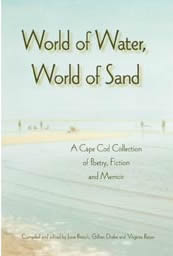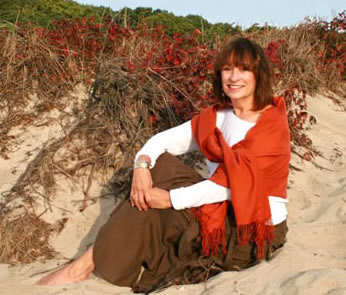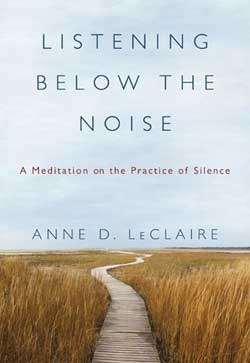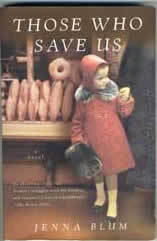
To order, check your Cape Cod bookstore, or send a check for $19.95
($14.95 plus $5 shipping) to:
Shank Painter Publishing,
P. O. Box 720, N. Eastham, MA 02651
. . . . . . . . . . . . . . . . . . . . . . . . . . . . .
The following poem by is from the anthology of poetry, fiction and memoir about Cape Cod entitled "World of Water, World of Sand: A Cape Cod Collection of Poetry, Fiction and Memoir," published by Shank Painter Publishing.
On Becoming
by Marjorie Block
Midway through a forest
a woman rises
padding on soft earth
finger to her lips
so as not to wake the others
who were watching,
she was sure,
from across a distance
from high up
from some window
behind a curtain.
Among towering trees
nine dancers
circle,
finger her hem
trailing, sweeping
the black dirt.
They crook fingers
beckon slyly,
lift long white arms
framing ageless
cameo faces.
Their scent vaporizes the air,
begs her to follow
along velvet moss
under a canopy of dark shapes
under a navy sky.
In the hour before light
a mourning dove calls.
Choose
perhaps the one standing there, apart
or the one whirling, whirling away.
Marjorie Block lived in New York City, California, and Chicago before moving to Dennis in 1980. Retired after 20 years of teaching in the Nauset School System, she now writes fiction and poetry. She has studied at the Fine Arts Work Center in Provincetown and in Italy at the Spoleto Writers’ Workshop.

Featured Author: Anne le Claire
Listening to Silence
by Anne le Claire
Book Review by Virginia Reiser
Novelist Anne LeClaire explores how practicing silence can guide us from transformation to transcendence in her new book, Listening Below the Noise: A Meditation on the Practice of Silence.

“I didn’t seek silence,” Anne LeClaire says, “rather it came to me.” Sixteen years ago, in search of comfort, she stood on the soft, buff-gray sands on a beach near her Chatham home and watched black and white eider ducks bob, then float on Nantucket Sound. As she tried to match her breath to their long underwater dives, she became imbued with a sense of gratitude so overwhelming she wondered what she should do. It was then a voice, not from within, but from somewhere beyond where she stood, said, “Sit in silence.” As she turned her head, wondering, it kept repeating, “Sit in silence. Sit in silence.”
Maybe it was the profound sense of gratitude, or maybe the way Anne has always tried to live her life with intention and insight, or both, that left her open and receptive rather than worrying she had suddenly gone crazy. She wasn’t sure what this voice meant, but when she returned home, on an impulse, she told her husband and a few friends that when she woke up the next morning she would not speak for 24 hours. Thus began what became not just a practice, but a way of life. For two days a month ever since, Anne chooses silence.
“In a way,” she says, “it’s about intent. I didn’t come to silence for self-help. And so I didn’t set goals but let myself be open to what it had to teach me.” What she found was that once she had tasted silence, it became nourishing, restorative, and she wanted to taste more. “The more I practiced it, the more I wanted to learn, to experience.” It was almost as if silence were a well with magical waters whose depths brought new lessons in mindfulness, new paths to the senses and creativity, and ultimately, to the power of stillness.
Silence, Anne believes, has been one of her greatest teachers. It remains, for her, a practice, and this very word means not achieving perfection as the old proverb, Practice Makes Perfect, says. A true practice means knowing that we must have the humility to understand that perfection is not the goal, merely a very faintly possible byproduct. It is in admitting what we do not know that we keep ourselves open to learning and experience, to new ways of becoming, being.
The core of silence is stillness, Anne has discovered. The ability to let what is before us merely unfold in all its wonder, either confused or ordered. “Attention is a form of prayer, or at least the first prerequisite,” she writes. Whether it is just listening to a friend’s troubles without the need to give advice, the total attentiveness paid while eating an apple—“The skin gave way beneath my teeth. The lightly grainy pulp sat on my tongue. Juice ran down my chin. I pictured the tree, the branch that had held it, the hard, brown seed it sprang from, the delicately tinted blossom it once had been, the sun that had warmed it, the land and water than had nourished it, the farmer who had picked it, the long and timeless story this one small fruit held.”—or the power inherent as the empty page fills, all are created from the wellspring of stillness.
Even when she felt resistance to silence, Anne let herself be attuned to what this, too, could teach. It is sometimes our very frustrations in a practice that lead to our deepest lessons, she has found. The surrounds of silence “can provide a neutral corner in which to sit, an opportunity to reflect rather than react . . . . Like a well, it offers us a reflection of ourselves, but a reflection in reverse so we can glimpse something unexpected . . . . On my silent days, I was being challenged to release illusions about myself.” Silence, she has discovered, is not a product, but a process. It is the belief in the process, that it will pull from us, like writing itself, what we most need that keeps us nourished and creative.
And Anne, too, has discovered that her process of silence, her practice of stillness, remains one of the greatest gifts to her creativity.
As Anne details in Listening Below the Noise, entering silence is akin to entering the wonder of one of her favorite childhood books, “The Secret Garden.” Like the key to the magical garden, silence, once found, is always there waiting for us. When Anne uses it to enter the world of stillness, she listens, deeply listens, both to what others and her own heart say. Silence has brought her to a fuller understanding of herself and others, has given her the ability to truly hear without the necessity of waiting to speak, even during speaking days, and brought deeper characterization and thought to her eight novels. But, most of all, it has granted her deeper spiritual awareness.
Our world today is so busy and full of noise, we have almost forgotten what silence means, Anne believes. Yet, it can be something profoundly life-changing and life-informing. Such a simple thing—and it costs nothing. But what if each of us entered our own home and tasted silence for just thirty minutes before turning on, listening to, or answering one of the myriad forms of what we have allowed to pass for communication today? What if, for one hour, one-half day, or as Anne practices, two days a month, we stopped and instead of speaking, listened—intently, intuitively, introspectively? What might we find?
“Our spirit,” Anne writes in this quietly reflective and beautiful book, “has an instinct for silence. Every soul innately yearns for stillness, for a space, a garden where we can till, sow, reap, and rest, and by doing so come to a deeper sense of self and our place in the universe. Silence is not an absence but a presence. Not an emptiness but repletion. A filling up.”
Anne le Claire teaches seminars on the practice of silence. Check her website www.anneleclaire.com for future times and places. She also teaches workshops at writer Joan Anderson’s retreats for women–go to www.joanandersononline.com and click on retreats.
Photo by Christopher LeClaire
Virginia Reiser is a writer and editor who lives in the oldest house in Dennis. Her short story, “Pasta della Nonna,” won best fiction in Cape Women magazine, and she has written many articles for local magazines and newspapers. Currently she is working on a novel, Absolution.
"Listening Below the Noise:
A Meditation on the Practice of Silence"
by Anne LeClaire
(Harper Collins, 240 pp, $19.95)
is available in bookstores this month and at
www.amazon.com

Book Review by Pat Bertschy
"Those Who Save Us"
a novel by Jenna Blum
Harcourt Books, 2004

This story begins in Germany with Anna, aged 19, on the eve of World War II. Her father’s dog is choking and in her panic the German girl rushes to the home of the nearest Doctor—a Jew. When the doctor tells Anna that she has risked arrest by entering the Jewish Quarter, it becomes obvious that Anna does not share the Nazi attitude of intolerance. As the two become friends, Anna begins to comprehend what is happening to the Jews. The rest of Anna’s story, including the birth of her daughter Trudy and her role helping Jews, is only half of the book.
Fifty years later, Anna is living out her life in New Heidelburg, Minnesota. She is silent about the war years. When her daughter Trudy, now nearing 50, embarks on “The German Project” under the auspices of the University of Minnesota, where she teaches History, Trudy finds herself interviewing German civilians now living in the US about their experiences in wartime Germany.
Through these interviews, Trudy learns much about the roles of German citizens during that time. She has her own vivid and frightening memories of the first five years of her life living with her mother in Germany, but she is not sure whether they are real or dreams. As Trudy interviews her subjects, her own memories stir and she begins to understand that her mother was no ordinary citizen.
One of Trudy’s interviews is with a woman who, as a young girl, wanted to help the Jews, but was paralyzed with fear from what she witnessed: “The Jews had been made to undress and were standing at the edge of a pit . . . and the Einsatzgruppen were shooting them in groups of four or five . . . the shame of it, the women and the children naked with the men, I had never seen such a thing.”
This book is difficult to read because of the horrific cruelty and unspeakable crimes committed against innocent people, but it is compelling. As Anna’s story slowly unfolds, the reader wonders how much of her story Trudy will learn.
Through the interviews and her own memories, Trudy is able to piece together some of her mother’s story, but not enough. “Those Who Save Us” speaks to anyone who has lost a parent to the silence of dementia, death or the living silence of estrangement. The loss is the same: irrecoverable memories, the incompletion of your own story. Trudy believes that knowing her mother’s tale would bring the connection she longs for, but her mother lived the cruelty and shame, and does not want to talk of it.
Trudy tries to respect her mother’s silence when she reflects: “It is her [Anna’s] decision not to speak of the things she has done, valiant or otherwise. It is in fact her prerogative as a hero. And . . . whether she is a hero or not is immaterial. Each person has this choice to make about how to live with the past, this dignity, this inviolable right.”
I wondered when I picked up Jenna Blum’s book, “Do we really need another story of the Holocaust?” My answer is yes. There are as many stories as there are witnesses. There can never be enough stories told until we have heard one for every victim—Jew or German. Blum’s book is valuable because she has collected some of those stories, but also because she raises the corollary question: Do adult children have the “right” to their parents’ story or do we owe our parents their dignity, their privacy?
Reviewed by Pat Bertschy, an avid Cape reader who misses her mother’s stories.
___________________________________________________
A BOOK IN THE HAND
Celebrating the tactile pleasure of the printed page
and the intimacy of the spoken word.
A series of monthly readings by
Cape Cod authors
of published prose.
Jacob Sears Memorial Library
23 Center Street, East Dennis •
508-385-8151
The 2nd Monday of every month, 7:00pm — 8:30pm
2009 SCHEDULE
February 9:
John Prophet : Mystery At Salt Marsh Bridge
and Body In The Salt Marsh (novel)
Marcia Monbleau : The Inevitable Guest etc (humor)
March 9:
Shirley Vogel : Whispers (a personal spiritual journey)
Lauren Wolk : Those Who Prefer Fire (novel)
April 13:
Jim Coogan : Priscilla the Amazing Pinkywink (children’s book)
May 11:
Ted Shrady : The Orange Blossom Special—Florida’s Distinguished Winter Train and/or The Sleeping Car – A General Guide (non-fiction)
Pat Reck: A Japanese Journey: Alone in the Land of the Rising Sun (memoir/travel)
___________________________________________________
Saturday, March 7 and March 21
9:00 to 12:00
Michele Wolfson
3811 Rte 6A, Brewster, MA
Call (508) 349-3790
for further information.